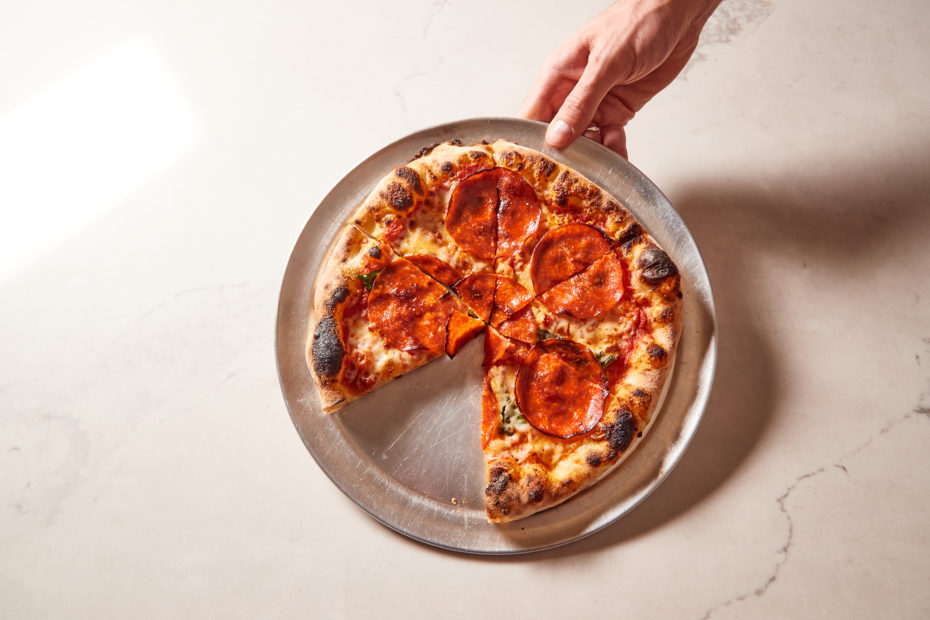When you pick up a slice of our best-selling pizza—the Diavola—you probably think that you’re tasting an echo of our pizza’s Neapolitan heritage. What could be more Italian than pepperoni, basil and chili flake after all?
Well, as it turns out, almost every other topping! Pepperoni, despite its Italian-sounding name, is as American as apple pie. (There is such a thing in Italian as peperoni, but all that translates to is large or bell pepper, and has nothing to do with any kind of meat product.)
What is pepperoni?
Pepperoni is essentially an American version of salami, something close to what Italians might call salame piccante, a generic term that means “spicy salami.” It’s made from beef and cured pork mixed together and then seasoned with a blend that usually includes paprika, garlic, black pepper, crushed red pepper, cayenne pepper, mustard seed, and fennel seed. Every pepperoni producer uses a different mix and ratio of ingredients, but paprika is always present: it’s what gives pepperoni its color. And clearly that list of ingredients had some influence on the name!
After the meat is trimmed to achieve the proper fat-to-meat ratio, it’s ground, combined with lactic acid bacteria, and finally fermented, smoked, dried, and stuffed into casing. Ecco!
So where did it come from?
Italian immigration into the US increased dramatically in the early 20th century, and these immigrants began combining their southern European flavor traditions with American ingredients.
In 1919 we see the first mention of pepperoni in the Italian-American delis of Lower Manhattan, though during the First World War the word started being used among Italian-American soldiers as a synonym for sausage. After the war, pepperoni began to appear as a pizza topping, though still primarily in pizzerias in New York City.
Colin Caplan, author of New Haven Apizza, says that it wasn’t until the mid-20th century that the real marriage of pizza and pepperoni was celebrated. The first evidence he found of pepperoni as a pizza topping came in 1950 from a photo of a wall menu at a pizzeria named The Spot in New Haven, Connecticut. Since then it began to trickle into toppings selections around the country.
But… why?
Darren Ezzo, of Ezzo Sausage in Columbus, Ohio, has a theory.
Readers of this blog will remember that pizza originated in Naples, prepared with simple and fresh ingredients: a basic dough, raw tomatoes, fresh mozzarella cheese, fresh basil, and olive oil. There weren’t any additional toppings, and in fact even tomatoes didn’t hit the dough until the late 1800s.
Ezzo looks instead at the food available to working-class Italian immigrants to New York: there were lots of tomatoes, for example, but no fresh basil—so the basic recipe from home was already perforce changing. Meats they were used to, like capicola, took months to season and prepare—far too long to then be “wasted” on a mere pizza. Enter pepperoni, which hangs for only one to three weeks, and a version of fast-food (the term is relative!) was born.
And speed became essential. As pizza gained in popularity in the United States and chain franchises (like Pizza Hut and Domino’s) began opening, ingredients needed to be mass-produced, easy to supply, and—most of all—readily available. Pepperoni filled all those requirements. “Pepperoni wasn’t really something people were doing a whole lot of until the chains really started popping up,” admits Ezzo.
Here to stay
Since that time in the 1960s there’s been no looking back. Most Americans hear the word “pizza” and immediately visualize a cheese pie with pepperoni on top. It’s that simple.
The only question isn’t whether or not we should eat pepperoni; it’s which pepperoni is the best. Opinion is divided on whether a slice of the stuff should curl when cooked, or lie flat. Some say that the little cups of cooked pepperoni perform an important job: confining the spicy, molten fat from pouring out over the surface of the pizza. Others are looking for a (slightly) healthier, flat disc. We prefer our oversized large diameter pepperoni to ensure you get a little in each bite.
What isn’t in dispute is its popularity. Of the three billion pizzas consumed annually by Americans, pepperoni accounts for a whopping 53%. We’re not surprised—it’s the favorite topping of Pizzeria Locale customers, too!



